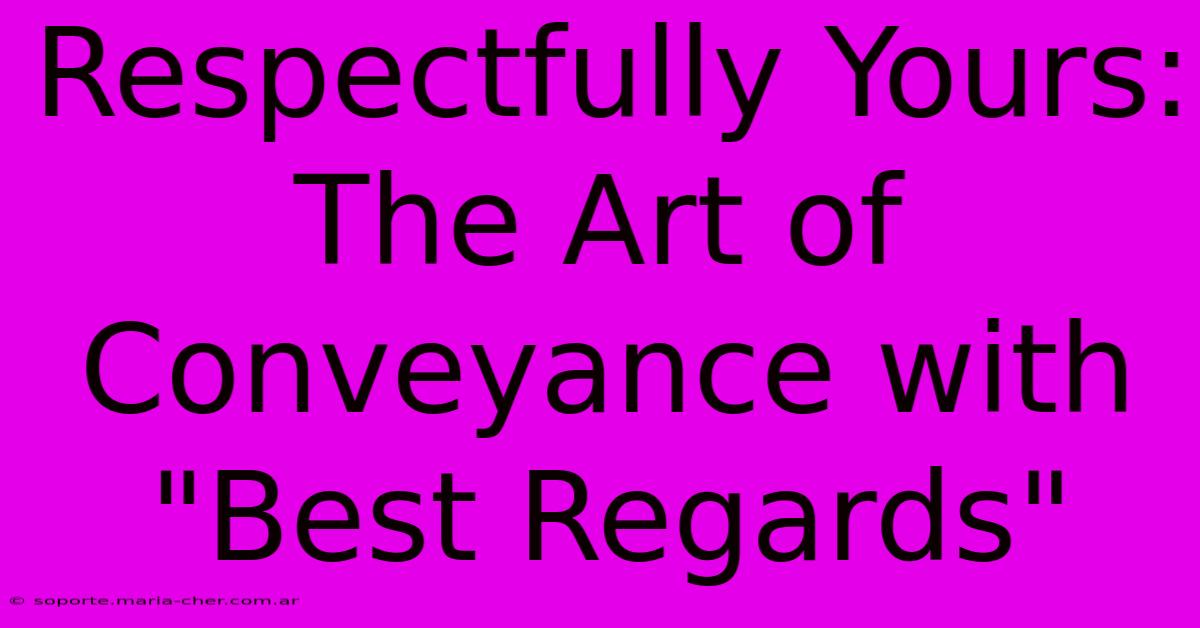Respectfully Yours: The Art Of Conveyance With "Best Regards"

Table of Contents
Respectfully Yours: The Art of Conveyance with "Best Regards"
In today's fast-paced digital world, the art of crafting a professional and respectful closing to your correspondence can often be overlooked. Yet, the simple act of choosing the right sign-off can significantly impact how your message is received. While a simple "Thanks" might suffice in casual emails, formal communication often calls for a more nuanced approach. This is where "Best Regards" and similar expressions shine, demonstrating respect and professionalism. This article explores the subtle nuances of using "Best Regards" and other courteous closings, helping you choose the perfect sign-off for every situation.
Understanding the Power of a Professional Closing
The closing of your email, letter, or other correspondence is your final opportunity to make a lasting impression. It's the punctuation mark on your communication, leaving a lingering feeling with the recipient. A well-chosen closing reflects your professionalism, consideration, and attention to detail. Conversely, an inappropriate or careless closing can undermine the entire message, leaving a negative impression.
Why "Best Regards" Works
"Best Regards" is a versatile and widely accepted closing that conveys politeness and respect. It's formal enough for professional communications yet warm enough to avoid sounding overly stiff. It's suitable for a broad range of recipients, from colleagues and clients to superiors and potential employers. Its strength lies in its neutrality – it doesn't presume a pre-existing close relationship, making it appropriate for both established and new contacts.
When to Use "Best Regards" and Alternatives
While "Best Regards" is a solid choice for many situations, understanding its context is key. Here's a breakdown of when it's most appropriate, along with suitable alternatives:
Situations where "Best Regards" is Ideal:
- Professional Emails: Business correspondence, client communication, job applications, and networking emails all benefit from the formality and respect conveyed by "Best Regards".
- Formal Letters: Letters to government officials, institutions, or individuals in positions of authority typically require a more formal closing such as "Best Regards" or "Sincerely".
- Business Proposals: Presenting a professional image is paramount in business proposals; "Best Regards" helps maintain that professionalism.
Alternatives to "Best Regards":
The choice of closing often depends on your relationship with the recipient and the tone of your communication. Consider these options:
- Sincerely: A more formal and traditional closing, suitable for formal letters and official correspondence.
- Sincerely yours: A slightly more personal variation of "Sincerely."
- Cordially: A friendly yet professional closing, suitable for colleagues and clients you have a more established relationship with.
- Kind regards: A warmer and more personal alternative to "Best Regards," appropriate for established professional relationships.
- Warmly: A more casual and friendly closing, suitable for close colleagues or friends.
Avoiding Common Mistakes
While the choice of closing might seem trivial, certain mistakes can undermine your professionalism. Avoid:
- Overly casual closings: Avoid closings like "Cheers," "Talk soon," or "Catch you later" in professional communications.
- Inconsistent closings: Maintain consistency in your closings throughout your correspondence with a particular individual or organization.
- Using no closing at all: Always include a closing to show respect and professionalism.
Mastering the Art of the Closing
Choosing the right closing is a small detail that can significantly impact your professional image. By understanding the nuances of different closings and selecting the most appropriate one for each situation, you demonstrate professionalism, respect, and attention to detail. Mastering the art of the closing is a valuable skill in cultivating strong professional relationships and leaving a positive lasting impression. Using "Best Regards" or its suitable alternatives effectively will enhance your communication and strengthen your professional presence.

Thank you for visiting our website wich cover about Respectfully Yours: The Art Of Conveyance With "Best Regards". We hope the information provided has been useful to you. Feel free to contact us if you have any questions or need further assistance. See you next time and dont miss to bookmark.
Featured Posts
-
Capture Flawless Memories The D Lux 6s Precision Optics And Advanced Image Stabilization
Feb 09, 2025
-
Mri Miracle Stunning Images Of Your Heart Surprisingly Affordable
Feb 09, 2025
-
Mesmerizing Metallic Gold Foil Nail Designs For Every Occasion And Style
Feb 09, 2025
-
Sapphire Secrets Unveiling The Hidden Depth Of Julys Blue
Feb 09, 2025
-
Unveiling The Secret American Flag With Red Line A Symbol Of Courage Or Division
Feb 09, 2025
